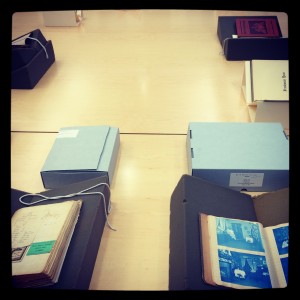Author Archives: Monica L. Mercado
Wiki Education Foundation at Bryn Mawr
 This month, the Greenfield Digital Center for the History of Women’s Education and Bryn Mawr LITS are pleased to partner with the Wiki Education Foundation to discuss how and why instructors might consider building Wikipedia assignments into coursework.
This month, the Greenfield Digital Center for the History of Women’s Education and Bryn Mawr LITS are pleased to partner with the Wiki Education Foundation to discuss how and why instructors might consider building Wikipedia assignments into coursework.
On Tuesday, February 16 from 4:30-6pm in the Quita Woodward Room (Thomas Hall), we will host a workshop with Jami Mathewson, Educational Partnerships Manager at Wiki Ed, who will introduce the resources and tools available to support instructors teaching with Wikipedia. Jami will bring ideas from the NWSA women’s studies initiative, and share new plans for 2016’s Wikipedia Year of Science — including ways for instructors and students to join efforts aimed at increasing the representation of women in science on Wikipedia.
RSVP for the workshop here. Bring your devices, your questions, and your ideas!
Wikipedia and Women’s Studies
For more than a year, we’ve been following the National Women’s Studies Association’s Wikipedia Initiative, addressing the vast gender gap on Wikipedia. The easiest way to improve Wikipedia’s representation of women, they have shown, is to participate in the Wikipedia Education Program, a project in which students contribute content to Wikipedia in place of a traditional research paper through a classroom activity. The Wikipedia Education Program in the United States and Canada is run by the Wiki Education Foundation, a nonprofit organization that builds connections between universities and Wikipedia and other Wikimedia projects in the United States and Canada.
About Wikipedia
One of the world’s most widely read websites, with approximately 550 million unique visitors per month, Wikipedia articles are often the number one hit when using a search browser. Its broad public presence, open for editing to anyone, offers a unique opportunity to participate in an online community of practice.
Why teach with Wikipedia?
As an educational tool, the development of Wikipedia articles allows students to create collaborative work with a visible impact on a global audience. Whether adding new sources to existing Wikipedia pages or creating new pages on notable topics, students gain deeper insight into their course material and learn to evaluate critically the reliability of sources. With faculty and students reporting enthusiasm and high levels of motivation for the Wikipedia assignment over the more traditional, Wikipedia assignments have the potential to deliver education that goes beyond a semester.
Questions? Contact Monica L. Mercado, Director of the Greenfield Digital Center, at mmercado@brynmawr.edu. All are welcome.
Daughters of the Samurai: Author Janice Nimura visits Bryn Mawr
Bryn Mawr College is delighted to welcome Janice P. Nimura to campus on Tuesday, January 26, 2016. Nimura is the author of Daughters of the Samurai: A Journey From East to West and Back, published in 2015 by Norton. According to the publisher:
 Daughters of the Samurai describes the journey begun in 1871, of five young girls who were sent by the Japanese government to the United States. Their mission: learn Western ways and return to help nurture a new generation of enlightened leaders in Japan. Raised in traditional samurai households during the turmoil of civil war, three of these unusual ambassadors—Sutematsu Yamakawa, Shige Nagai, and Ume Tsuda—grew up as typical American schoolgirls. Upon their arrival in San Francisco they became celebrities, their travels and traditional clothing exclaimed over by newspapers across the nation. As they learned English and Western customs, their American friends grew to love them for their high spirits and intellectual brilliance. The passionate relationships they formed reveal an intimate world of cross-cultural fascination and connection. Ten years later, they returned to Japan—a land grown foreign to them—determined to revolutionize women’s education. Based on in-depth archival research in Japan and in the United States, including decades of letters from between the three women and their American host families, Daughters of the Samurai is beautifully, cinematically written, a fascinating lens through which to view an extraordinary historical moment.”
Daughters of the Samurai describes the journey begun in 1871, of five young girls who were sent by the Japanese government to the United States. Their mission: learn Western ways and return to help nurture a new generation of enlightened leaders in Japan. Raised in traditional samurai households during the turmoil of civil war, three of these unusual ambassadors—Sutematsu Yamakawa, Shige Nagai, and Ume Tsuda—grew up as typical American schoolgirls. Upon their arrival in San Francisco they became celebrities, their travels and traditional clothing exclaimed over by newspapers across the nation. As they learned English and Western customs, their American friends grew to love them for their high spirits and intellectual brilliance. The passionate relationships they formed reveal an intimate world of cross-cultural fascination and connection. Ten years later, they returned to Japan—a land grown foreign to them—determined to revolutionize women’s education. Based on in-depth archival research in Japan and in the United States, including decades of letters from between the three women and their American host families, Daughters of the Samurai is beautifully, cinematically written, a fascinating lens through which to view an extraordinary historical moment.”
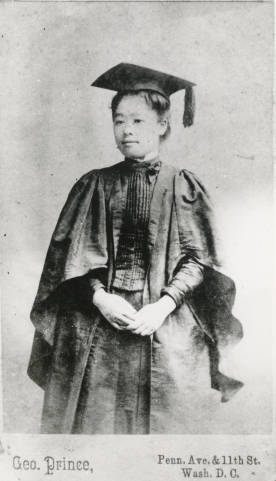
Ume Tsuda portrait, 1890. Bryn Mawr College Special Collections.
One of these young women, Ume Tsuda, attended Bryn Mawr College. Upon her return to Tokyo, she founded a similar institution for Japanese > women, which grew into the important and prestigious Tsuda College of today. The connection between Bryn Mawr and Tsuda Colleges has remained strong over the years and sparked a host of connections between Tri-Co colleges and Japan over the years.
Nimura will visit with staff and students in Taylor Hall from 1:30-2:30pm today, an informal opportunity to discuss the book and women’s international education initiatives. She will also speak to students in HIST 303: History in Public: Race, Gender, and Campus Memory from 3-4pm.
- For more on Japanese ties to U.S. women’s education, read Febe Pamonag’s 2012 article, “‘A Bryn Mawr School in the East: Transpacific Initiatives for Japanese Women’s Higher Education,” in Pacific Historical Review 81.4 [link to full text on Tripod].
- For more on Janice Nimura, visit the author’s website.
“College Women” at the Digital Library Federation Forum [video]
Link
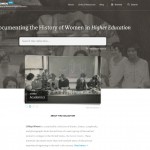 The October talk featuring Greenfield Director Monica Mercado, Rachel Appel (Bryn Mawr College Digital Collections Librarian) and Joanna DiPasquale (Vassar College Digital Initiatives Librarian) is now online via The University of British Columbia Open Collections. “College Women: A Collaborative, Cross-Institutional Archives Portal” begins at 00:14:50.
The October talk featuring Greenfield Director Monica Mercado, Rachel Appel (Bryn Mawr College Digital Collections Librarian) and Joanna DiPasquale (Vassar College Digital Initiatives Librarian) is now online via The University of British Columbia Open Collections. “College Women: A Collaborative, Cross-Institutional Archives Portal” begins at 00:14:50.
“Teaching History through Archives” at AHA 2016
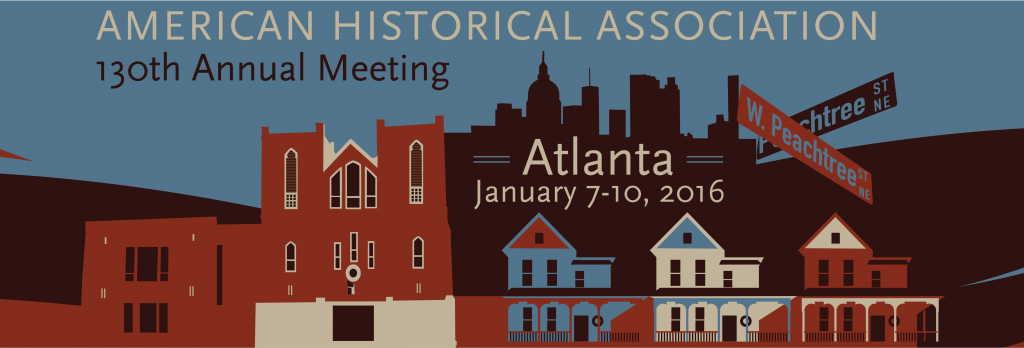 Going to AHA 2016? Greenfield Director Monica Mercado will be co-chairing the Committee on Women Historians mentoring/brainstorming session on Saturday, January 9, and later that day will be speaking about Bryn Mawr College projects on the panel “Teaching History through Archives.” Her paper, “Archives Praxis: Supporting Independent Study and Experiential Learning in Special Collections,” will detail student work including “Black at Bryn Mawr” and “We Are/We Have Always Been,” initiated by undergraduate student researchers:
Going to AHA 2016? Greenfield Director Monica Mercado will be co-chairing the Committee on Women Historians mentoring/brainstorming session on Saturday, January 9, and later that day will be speaking about Bryn Mawr College projects on the panel “Teaching History through Archives.” Her paper, “Archives Praxis: Supporting Independent Study and Experiential Learning in Special Collections,” will detail student work including “Black at Bryn Mawr” and “We Are/We Have Always Been,” initiated by undergraduate student researchers:
For more on the conference, follow the #AHA16 Twitter stream or search the online program.
“Sisters Launch Digital Archive” in the Alumnae Bulletin
Thanks to the Bryn Mawr Bulletin for featuring our seven institution collaboration, College Women: Documenting the History of Women in Higher Education in the November 2015 issue, which also features an important set of “Letters to the Editor” on the topic of Black at Bryn Mawr. We look forward to sharing our work with more alumnae/i in the new year!
Read more at the Bulletin site, here, and explore the College Women site online at collegewomen.org.
Finding Religion at College? Documenting the History of Women in Higher Education
Featured
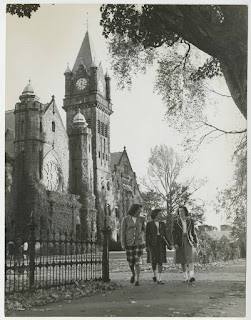
Mount Holyoke students walking by Abbey Chapel, ca. 1940s. Mount Holyoke College Archives and Special Collections, via collegewomen.org.
After returning from the Digital Library Federation Forum in Vancouver, I reflected on one of the College Women site’s lesser themes, religion. How might we go about studying religion at the women’s colleges?
As someone who has studied, taught, and written about American religion and American women’s higher education separately for quite some time, I’m intrigued by conversations about the place of religion on college campuses, in both the built environment and the curriculum. Our Seven Sisters digital project (collegewomen.org) and conversations with my students who participate in religious life on the 21st-century campus show me new ways of continuing these lines of inquiry, in the College Archives and in our new virtual portal.
Read more over at Religion in American History: Finding Religion at College? Documenting the History of Women in Higher Education. [link]
‘College Women’ Goes West: DLF Forum 2015
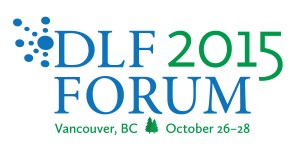 We’re in beautiful Vancouver, BC this week for the Digital Library Federation Forum. On Tuesday afternoon, Greenfield Director Monica Mercado, Bryn Mawr College digital collections librarian Rachel Appel, and Vassar College Libraries digital initiatives librarian Joanna DiPasquale will be presenting a project update on our archives portal, College Women: Documenting the History of Women in Higher Education.
We’re in beautiful Vancouver, BC this week for the Digital Library Federation Forum. On Tuesday afternoon, Greenfield Director Monica Mercado, Bryn Mawr College digital collections librarian Rachel Appel, and Vassar College Libraries digital initiatives librarian Joanna DiPasquale will be presenting a project update on our archives portal, College Women: Documenting the History of Women in Higher Education.
There’s a few ways to follow along:
- At DLF? Join our session in Ballroom I [Sched link here].
- Twitter: #DLFforum
- Crowdsourced note taking: Google Docs
- Livestream (starting at 1:30 PDT, 4:30 EST): sign up to receive login information.
We’re looking forward to presenting with the University of Virginia Scholars Lab project Take Back the Archive, a public history project created by UVa faculty, students, librarians, and archivists to “preserve, visualize, and contextualize the history of rape and sexual violence at UVa, honoring individual stories and documenting systemic issues and trends.” How can digital women’s archives work together and share in other conversations after we return to Bryn Mawr?
Greenfield in the Classroom
Although I’m not teaching a course this semester, I’m still getting to spend time in the classroom, sharing the Greenfield Digital Center’s resources with students and faculty across disciplines. Together we look not only at the growing array of resources Greenfield supports on the web – collegewomen.org, Black at Bryn Mawr, and Greenfield’s own collections exhibits – but also at materials housed in the College Archives: scrapbooks, photograph albums, papers, and more. Some classes are an obvious choice for a Special Collections visit, such as Professor Alicia Walker’s seminar, “Building Bryn Mawr,” where students are studying the early stages of development of Bryn Mawr’s campus, exploring the ways in which the founders of Bryn Mawr understood architecture as a key aspect of the institution’s image and aspirations. But I’ve also worked with faculty to integrate archives materials with class sessions on race and photography, or storytelling and digital narratives. If you ask me, the possibilities are endless! Continue reading
Black at Bryn Mawr: What’s Next?
Featured
* cross-posted from the Black at Bryn Mawr blog *

Good question!
I’ve been invited by the Bryn Mawr College Pensby Center to kick off this year’s Diversity Conversations programming – this Wednesday, September 30 at noon – with a look at the past, present, and future of the Black at Bryn Mawr project. During 2015-2016, I will continue to manage the project, providing new research and integrating it with my teaching and the work of the Greenfield Digital Center. I feel the loss of the project’s creators, Emma Kioko ’15 and Grace Pusey ’15 greatly — their energy and expertise made Emma’s idea for a Black history walking tour real, and far more successful than we ever could have imagined at this time last year. Our students graduate, and move on in their research and careers; talk of sustainability for campus history projects in the small liberal arts college environment must reflect this.
For those who can not attend the conversation, I am making my slides available via Slideshare (click here) and welcome comments and further questions below. Today’s presentation also dovetails with the work I am just beginning as a co-organizer of the 2016 NCPH Working Group “Campus History as Public History,” which is taking applications through October 15, 2015. Can we create best practices for these kinds of projects?
As always, the conversation also continues on Twitter: #BlackatBrynMawr and #campushistories.

